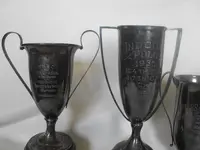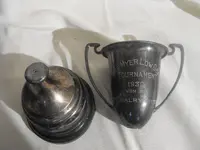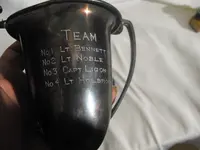You are using an out of date browser. It may not display this or other websites correctly.
You should upgrade or use an alternative browser.
You should upgrade or use an alternative browser.
Antique Military Trophies
- Thread starter mojjax
- Start date
randazzo1
Bronze Member
- Joined
- Feb 1, 2006
- Messages
- 1,581
- Reaction score
- 1,746
- Golden Thread
- 0
- Location
- New York, NY
- 🏆 Honorable Mentions:
- 1
- Detector(s) used
- Whites (CM 5000, XLT, VX3) and Minelab (Svgn GT & Excal III & Equinox)
- Primary Interest:
- All Treasure Hunting
Those are really cool!
This has something to do with Jackson Barracks.
https://neworleanshistorical.org/items/show/757
and
https://neworleanshistorical.org/tours/show/41
Great historic saves !
Don......
https://neworleanshistorical.org/items/show/757
and
https://neworleanshistorical.org/tours/show/41
Great historic saves !
Don......
Some history:
HISTORY OF POLO AND THE MILITARY
Polo in the U.S. Army can be traced back to 1892 when the 4th Cavalry Regiment established a regimental club in Washington State. In 1893, the cavalry at Fort Sill, Oklahoma formed a polo team using Indian ponies. In 1896, there was also Cavalry polo at Fort Riley, Kansas. In 1901, the U.S. Military Academy at West Point, New York, introduced polo. When the cavalry was replaced by field artillery in 1907, polo continued as an important equestrian activity throughout the Army. By 1914, there were 17 Army posts playing polo. In 1920, an Army Team was fielded and represented the U.S. in the Olympic Games at Antwerp, with the American squad emerging bronze medalists. In 1923, the U.S. Army Chief of Staff General John J. Pershing invited the British Army to send a polo team to the United States for a first ever international military polo championship. In 1928, the U.S. Army team made it to the final of the U.S. Open, and there were Army polo teams across the U.S. as well as in the Philippines, Hawaii and Panama. In the 1930s, at the height of polo's popularity in America, there were 1,200 military players, far outnumbering civilians playing the sport. The U.S. Army Cavalry was disbanded in 1950.
Why polo in the Army? Perhaps Gen. Patton said it best: “The virtue of polo as a military accomplishment rests on the following: it makes a man think fast while he is excited; it reduces his natural respect for his own safety - that is, makes him bold; it teaches restraint under exciting circumstances nearest to mounted combat; makes riding worthwhile; keeps a man hard and teaches better horse management.”
Also, the Army Polo Association described the sport as a “vital professional asset,” that improved players’ aggressiveness, decision making skills, teamwork and physical fitness.
Don.........
HISTORY OF POLO AND THE MILITARY
Polo in the U.S. Army can be traced back to 1892 when the 4th Cavalry Regiment established a regimental club in Washington State. In 1893, the cavalry at Fort Sill, Oklahoma formed a polo team using Indian ponies. In 1896, there was also Cavalry polo at Fort Riley, Kansas. In 1901, the U.S. Military Academy at West Point, New York, introduced polo. When the cavalry was replaced by field artillery in 1907, polo continued as an important equestrian activity throughout the Army. By 1914, there were 17 Army posts playing polo. In 1920, an Army Team was fielded and represented the U.S. in the Olympic Games at Antwerp, with the American squad emerging bronze medalists. In 1923, the U.S. Army Chief of Staff General John J. Pershing invited the British Army to send a polo team to the United States for a first ever international military polo championship. In 1928, the U.S. Army team made it to the final of the U.S. Open, and there were Army polo teams across the U.S. as well as in the Philippines, Hawaii and Panama. In the 1930s, at the height of polo's popularity in America, there were 1,200 military players, far outnumbering civilians playing the sport. The U.S. Army Cavalry was disbanded in 1950.
Why polo in the Army? Perhaps Gen. Patton said it best: “The virtue of polo as a military accomplishment rests on the following: it makes a man think fast while he is excited; it reduces his natural respect for his own safety - that is, makes him bold; it teaches restraint under exciting circumstances nearest to mounted combat; makes riding worthwhile; keeps a man hard and teaches better horse management.”
Also, the Army Polo Association described the sport as a “vital professional asset,” that improved players’ aggressiveness, decision making skills, teamwork and physical fitness.
Don.........
One or more of your trophies states: "Low Goal"; a term that may not be familiar; allow me to explain:
Polo players are rated on their ability, and are given a handicap which ensures that matches will be fair. Polo handicaps start at -2 for beginners, and end at 10 goals, for the world’s best players; unlike golf, the higher your handicap, the better a player you are.In order to form a team, the four players’ handicaps are added together to form a team handicap. Low goal polo is when the team handicap of the four players ranges from -8 to 8 goals, medium goal from 12-15, and high goal from 18 upwards. A few years ago, one four-man team was assembled (in Argentina) with a handicap of 40; perhaps the only such handicapped team ever assembled up to that time.
Don.....
Polo players are rated on their ability, and are given a handicap which ensures that matches will be fair. Polo handicaps start at -2 for beginners, and end at 10 goals, for the world’s best players; unlike golf, the higher your handicap, the better a player you are.In order to form a team, the four players’ handicaps are added together to form a team handicap. Low goal polo is when the team handicap of the four players ranges from -8 to 8 goals, medium goal from 12-15, and high goal from 18 upwards. A few years ago, one four-man team was assembled (in Argentina) with a handicap of 40; perhaps the only such handicapped team ever assembled up to that time.
Don.....
JimDon
Silver Member
Very cool find. Interesting history research everyone.
tamrock
Platinum Member
That's a nice find. I bought a golf trophy from the same era with the same deco design and plated white cast metal construction. I gave 12 bucks for it and it sold for $150. I think it was. I was a little surprised, as I didn't think the golfing event was anything of significants. Before I sold it I polished it with silver cream and I don't know if it's that kind of plating on pot metal or what, but the silver shine came out very un-even with dark spotting that wouldn't polish out. I thought I ruined it, but still I did okay selling it. I'm telling you that, as you might not wanna try and do that. It might be best to sell them untouched and let the buyer decide whether or not they wanna give em a shine.
Last edited:
Professor of Engineering
Ruby Member
- Joined
- Oct 5, 2014
- Messages
- 31,886
- Reaction score
- 35,434
- Golden Thread
- 1
- Location
- Massachusetts
- 🥇 Banner finds
- 1
- 🏆 Honorable Mentions:
- 1
- Detector(s) used
- Garrett: AT Pro, AT Gold & Infinium; Minelab: Explorer SE, II; Simplex; Tesoro: Tejon & Outlaw; White's: V3i
- Primary Interest:
- Relic Hunting
Very cool trophies! 

Similar threads
- Replies
- 3
- Views
- 813
Users who are viewing this thread
Total: 1 (members: 0, guests: 1)








